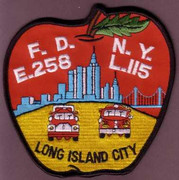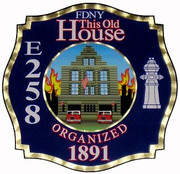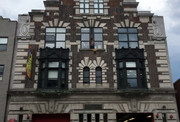Engine 258/Ladder 115 firehouse 10-40 47th Avenue Long Island City, Queens 14th Division, 45th Battalion
Engine 1 LICFD organized 12-17 Jackson Avenue w/Ladder 1 LICFD 1891
Engine 1 LICFD became Engine 1 FDNY 1898
Engine 1 FDNY became Engine 158 1899
Engine 158 new firehouse 10-40 47th Avenue w/Ladder 65 1904
Engine 158 became Engine 258 1913
Engine 258 moved 33-51 Greenpoint Avenue at Engine 259 1999
Engine 258 returned 10-40 47th Avenue w/Ladder 115 2000
Ladder 1 LICFD organized 12-16 47th Road former volunteer firehouse 1891
Ladder 1 LICFD became Ladder 1 FDNY 1898
Ladder 1 became Ladder 65 1899
Ladder 65 new firehouse 10-42 47th Avenue w/Engine 158 1904
Ladder 65 became Ladder 115 1913
Ladder 115 moved 11-15 37th Avenue at Engine 260 1999
Ladder 115 returned 10-40 47th Avenue w/Engine 258 2000
Search Light 4 Queens organized 10-42 47th Avenue at Engine 258 1930
Search Light 4 Queens moved 64-18 Queens Boulevard at Engine 292 1938
Search Light 4 Queens moved 56-29 68th Street at Engine 288 1966
Search Light 4 Queens disbanded 1968
Relay Hose Wagon 4 Queens organized 10-40 47th Avenue at Ladder 115 1942
Relay Hose Wagon 4 Queens disbanded 1945
Battalion 15 organized 12-17 Jackson Avenue at Engine 1 1898
Battalion 15 became Battalion 35 1898
Battalion 35 new firehouse 10-40 47th Avenue w/Engine 158 1904
Battalion 35 disbanded (reorganized in Brooklyn at Engine 111) 1906
Battalion 45 organized 10-40 47th Avenue at Engine 158 1906
Battalion 45 moved 33-51 Greenpoint Avenue at Engine 259 1979
Long Island City History:
Long Island City (LIC) was formerly a city, created in 1870, from the merger of the Long Island village of Astoria and the hamlets of Ravenswood, Hunters Point, Blissville, Sunnyside, Dutch Kills, Steinway, Bowery Bay and Middleton in Newtown Township. It was a separate city until it became part of New York City in 1898.
Long Island City 1873 map:
http://upload.wikimedia.org/wikipedia/commons/a/a0/1873_Beers_Map_of_Astoria_and_Long_Island_City,_Queens,_New_York_-_Geographicus_-_LongIslandCity-beers-1873.jpg
- Note: Blackwells Island (became Welfare Island, then Roosevelt Island); separate Ward's Island and Randall's Island; and ferries to Manhattan.
Long Island City - Volunteer fire department history:
There were over 20 volunteer fire companies that protected L.I. City, many of which were in service since the 1860s. All were disbanded by January 1, 1891 when a professional fire department, Long Island City Fire Department (LICFD) was put in place, .
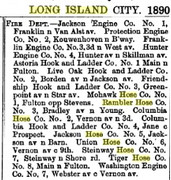
?Live Oak Truck No. 2?, a volunteer company of Hunter?s Point, was located at a wood-frame shed at Vernon & Borden Avenues. This became the initial quarters of Ladder 1, LICFD. In August 1893, Ladder Co. 1 occupied a leased 2-story brick firehouse at 178 7th Street (now 12-16 47th Rd) which was the rear of Engine Co. 1?s quarters that fronted on Jackson Avenue, which became Ladder 115.
Long Island City Fire Department (LICFD):
LICFD was a paid fire department which protected Long Island City in the 1890s before it became part of New York City in 1898. LICFD companies entered FDNY in 1989 and were renumbered in 1898 and later in 1913.
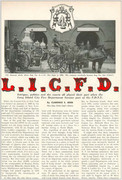
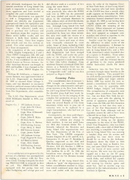
LICFD companies 1898:

12-17 Jackson Avenue firehouse:

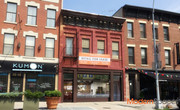
12-16 47th Road firehouse:
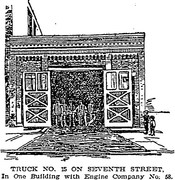
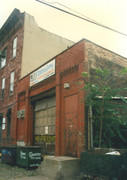
10-40 47th Avenue firehouse:
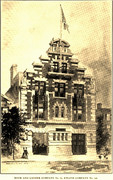

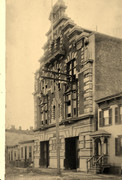
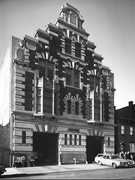

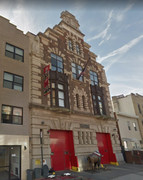
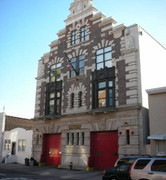
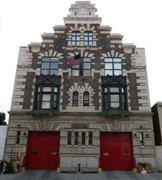

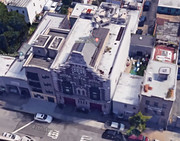

Engine 258:


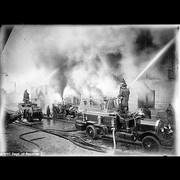



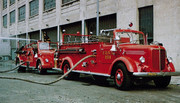

Ladder 115:



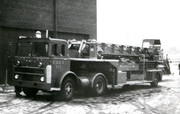

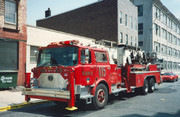




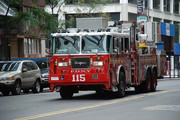
CPC 115:
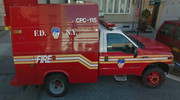
Engine 258/Ladder 115:
https://www.youtube.com/watch?v=AoKcym528_4
https://www.youtube.com/watch?v=TJ_qwtkAJU0
https://www.youtube.com/watch?v=GYqHaHb07bs
https://www.youtube.com/watch?v=tUUVtsxtKc4
Engine 258/Ladder 115 FDNY Medals:
VICTOR VAN ISEGHEM LT. ENG. 258 FEB. 24, 1947 1948 STIEFEL
WILLIAM C. RINSDALE FF. ENG. 258 OCT. 2, 1957 1958 HUGH BONNER
LODD BC William C. Rinsdale, August 1, 1971

THOMAS J. LUCAS FF. LAD. 115 OCT. 13, 1913 1914 BROOKLYN CITIZENS
Rescued 2 y/o William O?Donnell at fire 97 Jackson Avenue, October 13, 1913.

SASHA W. BURAK FF. LAD. 115 FEB. 24, 1947 1948 FDR
Later a Deputy Chief.
GREGORY PIROZZI FF. LAD. 115 OCT. 26, 1962 1963 KANE
Firefighter Gregory Pirozzi, Ladder 115, received a medal for saving the life of Lt. Walter Pollack of his company. The officer was one of nearly 20 firefighters who were trapped and injured in a collapse while operating at the fire. 6 firefighters were killed at this Maspeth factory fire, the Sefu Soap and Fat Co.
http://www.junipercivic.com/historyArticle.asp?nid=95
Engine 258/Ladder 115 LODDs:
FIREMAN PATRICK LENNON (Detailed from Engine 160) Engine 158 (258) December 1, 1904 injured November 26, 1904 Box 99-44 Queens Co. Court House, Jackson Avenue
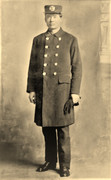
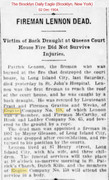
Fireman Patrick Lennon was burned while working on the roof of the Queens Co. Court House. The fire started around noon in the third floor kitchen, and spread up through the mansard roof by a strong North wind. Working on the roof at the time of the fire there was twenty one workers who entered through a skylight and became trapped by the flames. An aerial ladder was raised and all twenty one workers came down without any injuries. Fireman Lennon who was detailed to Engine 158 was ordered up to the roof with other members. Lennon was up the ladder first and when he stepped onto the roof, flames enveloped him. Other firemen removed him from the roof and he was removed to a hospital. He had inhaled flames and was badly burnt. While in the hospital, his condition started to improve but took a turn for the worse and died on December 1st.
FIREMAN EDWARD J. KNAPP Engine 258 July 7, 1927 Box 44-153 43-51 Purvis Street
Fireman Edward Knapp of Engine 258 was overcome by gas and died on the way to St. John's Hospital. He had reported to duty for his day tour and went to the fire with the rest of the crew to relieve the night tour, who had been fighting the four-alarm fire for five hours. He was operating at the ruins of the Manhattan Steam Bakery Co. at 43-51 Purvis Street. He died from carbon monoxide gas, having been created by the action of water on the hot ovens and the debris strewn about. Dr. Archer declared that Fireman Knapp's death was very unusual.
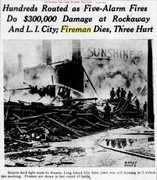
LIEUTENANT JAMES A. O'BRIEN (Detailed from L116) Engine 258 April 19, 1930 injured March 17, 1930 in the quarters of Engine 258
Lieutenant James O'Brien of Hook & Ladder 116 died as the result of injuries he received at Engine 258's quarters. On March 17, while detailed to Engine 258, he suffered burns to the eyes and the face when he fell carrying a pail of water containing caustic soda. He died at his home from pneumonia resulting from his injuries.

LIEUTENANT JOHN W. SMITH Ladder 115 June 18, 1933 (Injured May 19, 1933) Box 7209 25-19 Borden Avenue
Lieutenant John W. Smith was injured when he fell from the first floor to the basement after forcing a door to search for the fire. Other members of Ladder 115 heard him cry for help and ran to his aid. He suffered cuts about the head and possibly a fractured skull. He stayed in the hospital until June 16th at which time he went home. He had a relapse and returned to the hospital and died. He was 57 years and a veteran of thirty years on the job.
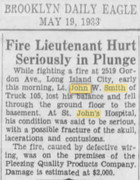

FIREMAN MICHAEL BERENZ Engine 258 October 22, 1957 (Injured January 26, 1957) Box 7369 38th Avenue & 10th Street
At 11:20 pm after returning from a fire at 38-25 9th Street, Fireman Michael Berenz of Engine 258 complained of severe pains in the chest. Rescue 4 and a public ambulance were called to quarters and administered oxygen. Fireman Berenz was removed by ambulance to St. John's hospital. Doctor Hania in attendance diagnosis possible Coronary Thrombosis. He died 10 months later from a fatal heart attack.
FIREMAN FRANCIS X. EGAN Ladder 115 October 26, 1962 Box 7027 56th Rd. & 48th Street
Firemen Richard Andrews, James Marino, Captain William Russell of Engine 325, Firemen Richard Gifford, George Zahn of Engine 238, and Fireman Francis Egan of Ladder 115, were killed by a falling wall during a fourth-alarm. At least seven other firemen were injured. The dead and injured firemen were trapped on the first floor of the factory, the Sefu Soap and Fat Co. at 44-15 56th Road in Maspeth. The men were buried In 6 feet of debris as the wall and ceiling of the two story brick building fell.
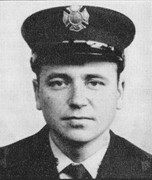
On October 26, 1962 a building collapse took the lives of six firemen at 44-15 56th Street. The five-alarm fire started around 9:30 at night at the Sefu Soap & Fat Company. It was placed under control at 10:30 and five minutes later a twenty-foot section of metal roofing over the loading dock came crashing down. The collapse took out the brick wall of the two-story building and buried twenty men. Heavy equipment was rushed in to assist in the digging for the buried men. Fourteen men were quickly dug out with various injuries and taken to area hospitals. The six that were killed were buried under six feet of debris. A worker started the fire during the day, using an acetylene torch to cut up old machinery. He had started two fires and put them out himself without calling the fire department. Killed in the fire were Captain William F. Russell, Fireman James M. Marino and Probationary Fireman Richard Andrews of Engine 325, Firemen Richard P. Gifford and George J. Zahn of Engine 238 and Fireman Francis X. Egan of Ladder 115. Captain Russell was forty-three years old while the others were all in their twenties.
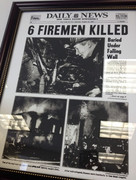
FIREMAN GERARD T. GANLEY (Detailed to E297) Engine 258 July 13, 1978 Box 4553 20th Avenue & 120th Street
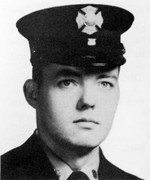
Fireman Gerard T. Ganley of E258, was detailed to E297 pending transfer to that unit. E297 was special called to a brush fire at 20th Avenue. While assisting in the stretching of a line, Fireman Ganley was stricken with a heart attack. He was removed to Parsons Hospital but was dead on arrival. He had 18 years of service in the fire department.
L.I.C. Volunteer FIREMAN MICHAEL RIGNEY Jackson Hose No. 5 July 17, 1888 Vernon Boulevard, Ravenswood
?The new factory of the New York Architectural Terra-Cotta Company was only in business since April before it was wiped out by fire. On Saturday, the workers had left the building around four o?clock in the afternoon and the night watchman was making his rounds around 10:30 that night when he discovered a fire on the top floor near the flues for the kilns. He tried to put the fire out but could not. The delayed alarm was sent out and the volunteer fire department responded. The three engines, six hose, and three ladder companies were soon hard at work. The closest hydrant was 1,000 feet away and hose lines were stretched to the fire. Somebody cut the hose line at the hydrant and it had to be replaced with a new line of hose. Fireman Michael Rigney of Jackson Hose 5 was on the west side of the boiler house directing a hose line when the wall fell on him and another fireman. Both men were quickly pulled from the rubble. Fireman Rigney suffered a hole in his head from a brick and a broken collarbone. The skin on his right hand was ripped off and the right side of his body was badly burned from the hip down. He was taken home and treated. He died from his injuries on July 31, 1888. The second fireman was from Hunter Engine 4 and only received a burned hand and a cut on his head.?
RIP. Never forget.
10-40 47th Avenue firehouse history:
Queenswalk: The Firehouse in Hunter?s Point: Engine Co. 258 and Ladder Co. 115
Brooklyn and Manhattan had fire companies that were established long before Queens? were. Long Island City, because it is so close to Manhattan and was the center of Queens? government, was the first part of Queens to get a professional fire company. That was in 1891. By comparison, independent cities like Manhattan and Brooklyn had professional companies mandated by state charter in 1865.
Before 1890, the separate towns that made up LIC had 12 volunteer fire departments. When the law authorizing paid departments in Queens was passed that year, all of the volunteer departments were disbanded, and five new houses were built for the new companies. When the city consolidated in 1898, these companies were brought under the control of a central New York City fire department.
In 1899, the city announced that they were authorizing the building of new fire houses in Brooklyn and Queens. The fire house on Jackson Avenue that contained Engine 258 was considered one of the worst and most dangerous in the city, ?a danger to life and limb,? according to the Brooklyn Eagle. The new fire house would be built on land purchased by the city at 10-40 47th Avenue, between Vernon Avenue and 11th Street.
The building was begun in 1902 and completed in 1904. It was built to accommodate Engine Co. 258, Ladder Co. 115, and headquarters for the battalion chief. It was close to the old fire house, but more importantly, close to Borough Hall and two important factories: the Pratt & Lambert Varnish Factory and an oil refinery for Standard Oil. The rest of the immediate neighborhood held schools, small businesses and a sizable residential area full of attached wood framed houses.
Over in Manhattan, the city had commissioned just one architect to design that city?s firehouses: Napoleon LeBrun. Between 1879 and 1894 he, and later with his sons, designed over 40 fire houses. Many still remain, and are gorgeous examples of civic architecture, and indeed worthy of Manhattan.
In Brooklyn, prior to 1898, that city had hired several of the best residential and commercial architects in that city to design firehouses. Peter J. Lauritzen, who designed my old Bedford Stuyvesant neighborhood?s firehouse on Madison Street was among them, as were the Parfitt Brothers, Frank Freeman, Frank J. Helmle and others. Their firehouses are also masterful and imaginative examples of fine civic architecture. Today, many of the fine fire houses of the LeBrun?s and the Brooklyn architects are protected by landmarking.
By 1900, the expanded Greater City of New York began hiring some new architects, and the most prominent of those was Ernest Flagg and Bradford Lee Gilbert. The two only designed three firehouses, but they were all masterful. Flagg?s were in Manhattan, and the architect of Engine Co. 258 was Bradford Lee Gilbert. A graduate of Yale University, he trained in the offices of Josiah C. Cady, a major talent who was the architect of the southern wing of the Museum of Natural History, as well as the old Metropolitan Opera House and the New York Presbyterian Hospital. Cady also designed 15 buildings on Yale?s campus, including the Peabody Museum, so no doubt that Yale connection was a plus.
In 1876, Gilbert was appointed architect for the New York, Lake Erie and Western Railroad. He designed buildings for them that can still be found throughout the eastern half of North America, including Detroit, Chicago, Ottawa and Halifax. He based his practice in Manhattan, and is credited as the architect of the first New York City skyscraper, the Tower Building, completed in 1899. It was located at 50 Broadway, and at eleven stories, was one of the first steel framed buildings in Manhattan. Gilbert was quite proud of this one, and maintained his office on the top floor of the building until his death in 1911.
Most of Gilbert?s designs were in the Romanesque Revival style, but for the new firehouse, he decided to reference New York City?s Dutch roots. The step gabled roofline is a classic feature of Dutch building, dating back as far as the late 14th century. This feature was especially popular on canal houses and row houses, where small lots necessitated multi-story buildings. The step gables used on Engine 258 are called ?proto-Baroque? by experts on Dutch building styles.
In any case, Gilbert was not the first to design Dutch Renaissance Revival firehouses. Napoleon LeBrun had designed one for the old Manhattan Engine Co. 15, now demolished. In Brooklyn, the Parfitt Brothers designed Engine Co. 253, which is in Bensonhurst, and landmarked. Both were before Gilberts? Long Island City firehouse. Gilbert himself alter designed more than a few building in this style, suggesting he really liked it, as the buildings are as far flung as a train station in Mexico, a YMCA in Harlem, a hospital complex in Staten Island, and a group of row houses in Manhattan.
Engine Co. 258 and Ladder Co. 115?s new building opened with great fanfare, in 1904. It?s a magnificent building, quite visually striking and a prominent part of the streetscape. The top part of the roof is five stories tall, putting it at least a story above the rest of the block. His use of materials creates a powerful contrast between the light colored quoins, the key surrounds on the windows and the ornament, and the darker burnt brick.
The building is 50 feet wide, built to accommodate both the engine and ladder trucks. The size of the building, and the bays themselves, predated our large fire trucks of today, but the building was built large enough to make housing them possible.
The tall structure could also accommodate hanging space for the hoses, which needed to be hung up lengthwise to dry properly when not in use. The firehouse also needed to have enough room to have a dormitory for the men, who at the time, worked 24-hour, six-day shifts before a day off. There were offices for the battalion commander, and the chief, as well as bathroom facilities, a day room and a kitchen/eating area.
Today, the firehouse is still in use, and a prominent landmark in the community. It?s been mentioned in every edition of the AIA Guide to New York City, and was called a ?gem? in Jeffrey Kroessler and Nina S. Rappaport?s book Historic Preservation in Queens. The building was also cited by the Queens Historical Society as a ?Queensmark,? a building with architectural, historic or cultural significance.
It may also be recognized as the firehouse serving as the headquarters for the firefighters and EMTs in the television series Third Watch, which aired from 1999-2005. The firehouse was landmarked in 2006.
https://www.brownstoner.com/queens/long-island-city/queenswalk-the-firehouse-in-hunters-point-engine-co-258-and-ladder-co-115/
Engine 258/Ladder 115 neighborhood:

http://forgotten-ny.com/2007/08/hunters-point-queens/
